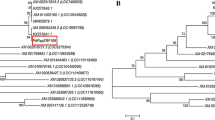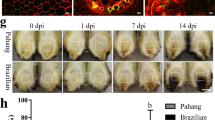Abstract
Vascular wilt pathogens, cause serious economic losses in annual crops as well as in woody perennials. Fusarium oxysporum and Verticillium dahliae belong to the most destructive vascular wilt fungi since they have a very broad host range and there is no chemical treatment to control them. Therefore, there is need for the development of novel disease control strategies, based on the understanding of the plant – pathogen interaction. Towards this direction, this study examined the role of the pyruvate decarboxylase encoding genes PDC1 and PDC2 upon V. dahliae and F. oxysporum infection. Less Verticillium and Fusarium wilt symptoms were recorded in the pdc1 mutants compared to wt and pdc2. Quantitative polymerase chain reaction analysis revealed that the decrease in symptom severity shown in pdc1 was associated with reductions in the growth of both pathogens in the vascular tissues of the plants. Furthermore, it was shown that PDC1 was up-regulated upon F. oxysporum and V. dahliae infection in the root and above ground tissues of the wt plants; while PDC2 was mainly suppressed. It is also suggested that the observed pdc1 resistance against F. oxysporum and V. dahliae is the outcome of the activation of the plant defense mechanisms.




Similar content being viewed by others
References
Campbell, C. L., & Madden, L. V. (1990). Introduction to plant disease epidemiology. New York: Wiley.
Czechowski, T., Stitt, M., Altmann, T., Udvardi, M. K., & Scheible, W. R. (2005). Genome wide identification and testing of superior reference genes for transcript normalization in Arabidopsis. Plant Physiology, 139, 5–17.
Dean, R., Van Kan, J. A., Pretorius, Z. A., Hammond-Kosack, K. E., Di Pietro, A., Spanu, P. D., Rudd, J. J., Dickman, M., Kahmann, R., Ellis, J., & Foster, G. D. (2012). The top 10 fungal pathogens in molecular plant pathology. Molecular Plant Pathology, 13, 414–430.
Delessert, C., Kazan, K., Wilson, I. W., Straeten, D. V. D., Manners, J., Dennis, E. S., & Dolferus, R. (2005). The transcription factor ATAF2 represses the expression of pathogenesis-related genes in Arabidopsis. Plant Journal, 43, 745–757.
Dellaporta, S. L., Wood, J., & Hicks, J. B. (1983). A plant DNA minipreparation, version 2. Plant Molecular Biology Reporter, 1, 19–21.
Edgar, C. I., McGrath, K. C., Dombrecht, B., Manners, J. M., Maclean, D. C., Schenk, P. M., & Kazan, K. (2006). Salicylic acid mediates resistance to the vascular wilt pathogen Fusarium oxysporum in the model host Arabidopsis thaliana. Australasian Plant Pathology, 35, 581–591.
Fradin, E. F., Abd-El-Haliem, A., Masini, L., van den Berg, G. C. M., Joosten, M. H. A. J., & Thomma, B. P. H. J. (2011). Interfamily transfer of tomato Ve1 mediates Verticillium resistance in Arabidopsis. Plant Physiology, 156, 2255–2265.
Heinz, R., Lee, S. W., Saparno, A., Nazar, R. N., & Robb, J. (1998). Cyclical systemic colonization in Verticillium-infected tomato. Physiological and Molecular Plant Pathology, 52, 385–396.
Jubault, M., Lariagon, C., Taconnat, L., Renou, J. P., Gravot, A., Delourme, R., & Manzanares-Dauleux, M. J. (2013). Partial resistance to clubroot in Arabidopsis is based on changes in the host primary metabolism and targeted cell division and expansion capacity. Functional and Integration Genomics, 13, 191–205.
Koornneef, A., & Pieterse, C. M. (2008). Cross talk in defense signaling. Plant Physiology, 146, 839–844.
Kursteiner, O., Dupuis, I., & Kuhlemeier, C. (2003). The pyruvate decarboxylase1 gene of Arabidopsis is required during anoxia but not other environmental stresses. Plant Physiology, 132, 968–978.
Leeman, M., van Pelt, J. A., den Ouden, F. M., Heinsbroek, M., Bakker, P. A. H. M., & Schippers, B. (1995). Lnduction of systemic resistance by Pseudomonas fluorescens in radish cultivars differing in susceptibility to fusarium wilt, using a novel bioassay. European Journal of Plant Pathology, 101, 655–664.
Lyons, R., Stiller, J., Powell, J., Rusu, A., Manners, J. M., & Kazan, K. (2015). Fusarium oxysporum triggers tissue-specific transcriptional reprogramming in Arabidopsis Thaliana. PLoS One, 10, e0121902.
Maniatis, T., Fritsch, E. F., & Sambrook, J. (1982). Molecular cloning, a laboratory manual. Cold Spring Harbor: Cold Spring Harbor Laboratory Press.
Mithran, M., Paparelli, E., Novi, G., Perata, P., & Loreti, E. (2014). Analysis of the role of the pyruvate decarboxylase gene family in Arabidopsis thaliana under low-oxygen conditions. Plant Biology, 16, 28–34.
Pantelides, I. S., Tjamos, S. E., & Paplomatas, E. J. (2010). Ethylene perception via ETR1 is required in Arabidopsis infection by Verticillium dahliae. Molecular Plant Pathology, 11, 191–202.
Pantelides, Ι. S., Tjamos, S. E., Pappa, S., Kargakis, M., & Paplomatas, E. J. (2013). The ethylene receptor ETR1 is required for Fusarium oxysporum pathogenicity. Plant Pathology, 62, 1302–1309.
Ralhan, A., Schoettle, S., Thurow, C., Iven, T., Feussner, I., Polle, A., & Gatz, C. (2012). The vascular pathogen Verticillium longisporum requires a jasmonic acid-independent COI1 function in roots to elicit disease symptoms in Arabidopsis thaliana shoots. Plant Physiology, 159, 1192–1203.
Remakers, C., Ruijter, J. M., Deprez, R. H., & Moorman, A. F. (2003). Assumption-free analysis of quantitative real-time polymerase chain reaction (PCR) data. Neuroscience Letters, 339, 62–66.
Sinha, A. K., & Wood, R. K. S. (1968). Studies on the nature of resistance in tomato plants to Verticillium albo-atrum. Annals of Applied Biology, 62, 319–327.
Tadege, M., Bucher, M., Stahli, W., Suter, M., Dupuis, I., & Kuhlemeier, C. (1998). Activation of plant defense responses and sugar efflux by expression of pyruvate decarboxylase in potato leaves. Plant Journal, 16, 661–671.
Taiz, L., & Zeiger, E. (1998). Plant physiology (2nd ed.). Sunderland: Sinauer Associates Publishers.
Thomma, B., Eggermont, K., Penninckx, I., Mauch-Mani, B., Vogelsang, R., Cammue, B., & Broekaert, W. (1998). Separate jasmonate-dependent and salicylate-dependent defense-response pathways in Arabidopsis are essential for resistance to distinct microbial pathogens. Proceedings of National Academy of Science U.S.A, 95, 15107–15111.
Tjamos, S. E., Flemetakis, E., Paplomatas, E. J., & Katinakis, P. (2005). Induction of resistance to Verticillium dahliae in Arabidopsis thaliana by the biocontrol agent K165 and pathogenesis-related proteins gene expression. Molecular Plant-Microbe Interactions, 18, 555–561.
van Wees, S. C., de Swart, E. A., van Pelt, J. A., van Loon, L. C., & Pieterse, C. M. (2000). Enhancement of induced disease resistance by simultaneous activation of salicylate- and jasmonate-dependent defense pathways in Arabidopsis thaliana. Proceedings of the National Academy of Sciences, USA, 97, 8711–8716.
Veronese, P., Narasimhan, M. L., Stevenson, R. A., Zhu, J. K., Weller, S. C., Subbarao, K. V., & Bressan, R. A. (2003). Identification of a locus controlling Verticillium disease symptom response in Arabidopsis thaliana. Plant Journal, 35, 574–587.
Acknowledgements
We thank Anna Mastromina for English language editing.
Author information
Authors and Affiliations
Corresponding author
Ethics declarations
Conflicts of interest
The authors declare that they have no conflict of interest.
Research involving human participants and/or animals
This chapter does not contain any studies with human participants or animals performed by any of the authors.
Informed consent
Informed consent was obtained from all individual participants included in the study.
Rights and permissions
About this article
Cite this article
Papastolopoulou, C., Diakou, G., Gkizi, D. et al. The pyruvate decarboxylase 1 (PDC1) gene: negative regulator of disease resistance for Fusarium oxysporum and Verticillium dahliae. Eur J Plant Pathol 152, 61–69 (2018). https://doi.org/10.1007/s10658-018-1448-1
Accepted:
Published:
Issue Date:
DOI: https://doi.org/10.1007/s10658-018-1448-1




